November 4, 2019
Asteroid Ryugu and the Pyramids
As if anxiously awaiting the end of the presentation on "The Forefront of Pyramid Research" by Associate Professor Yukinori Kawae of Nagoya University's Institute for Advanced Research, Professor Sei-ichiro Watanabe of the Graduate School of Environmental Studies opened his mouth, wanting to say, "That's just like the Hayabusa2 exploration on the asteroid Ryugu." Watanabe is a project scientist leading the science team for the Hayabusa2 asteroid exploration probe of the Japan Aerospace Exploration Agency (JAXA). Kawae had been explaining the process of taking extensive images of Egyptian pyramids by aerial drone and using them to create a precise 3D image that accurately portrays every stone. This was exactly the same way Hayabusa2 has created detailed images of the surface of Ryugu. Another similarity is the attempt to describe the interior and secrets of an object's origins using detailed data. How was the Great Pyramid, which has a base of about 230 meters, built 4,500 years ago? On the other hand, how was Ryugu, which has a diameter of about one kilometer, created when the solar system was formed 4.5 billion years ago? Obviously, the pyramids and Ryugu are entirely different things, but both continue to stir the human imagination. Researchers are trying to learn about them using cutting-edge science. Watanabe describes it like this: "Hayabusa2 is like a drone being used for the pyramids. It is helping us with archaeology from 4.5 billion years ago."
Ryugu has an angular shape like an abacus bead, with a peaked top and bottom, so Watanabe commented, "Ryugu is like a pyramid, with another one flipped over and attached to the bottom. They are really similar." I felt the thrill of seeing the links between leading-edge space science and archaeology.
All of this happened at a "Meidai Salon," which has presentations by researchers from various disciplines at Nagoya University, followed by an informal gathering with conversation over wine and some foods. Leaders from different fields have the opportunity to meet and discover unexpected connections. Researchers from fields such as physics and agriculture posed questions from their own perspectives. This must be one of the big attractions of what we call a university.
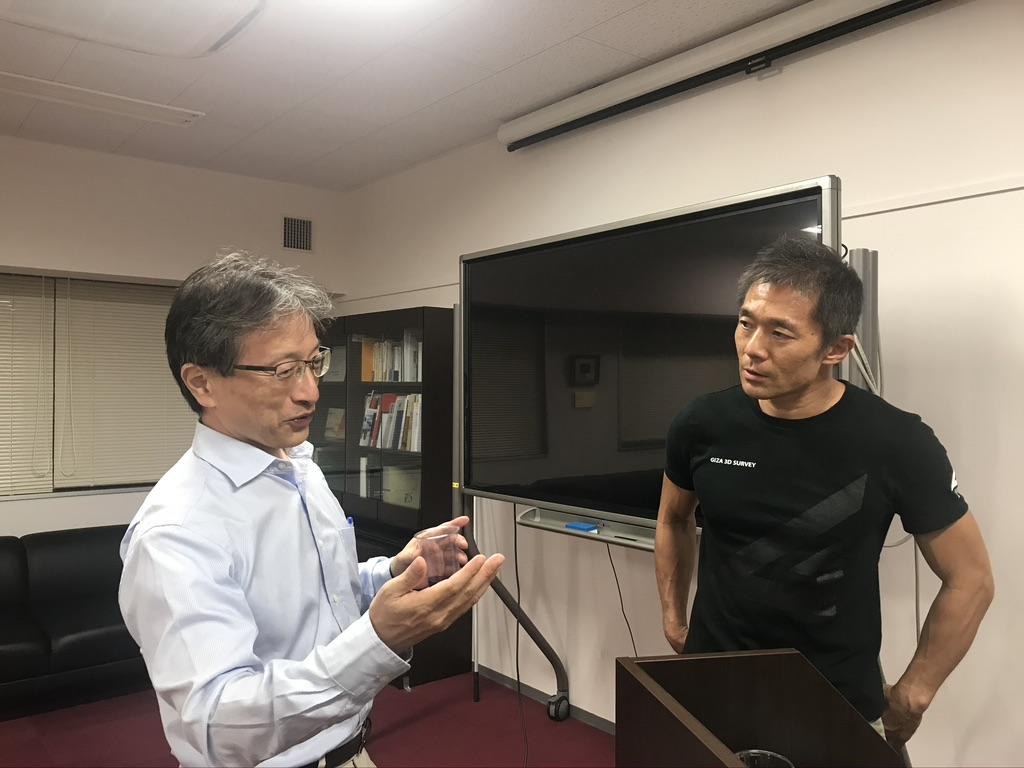 After a presentation by Associate Professor Yukinori Kawae (right), Professor Sei-ichiro Watanabe speaks with him about the Hayabusa2 space probe (at the Institute for Advanced Research, October 10, 2019)
After a presentation by Associate Professor Yukinori Kawae (right), Professor Sei-ichiro Watanabe speaks with him about the Hayabusa2 space probe (at the Institute for Advanced Research, October 10, 2019)
Kawae says that research at the pyramids of Egypt has produced some significant discoveries in recent years and a major turning point has been reached. One example is the discovery in 2017 of a large void in the Great Pyramid, by Designated Assistant Professor Kunihiro Morishima, who is from the same Institute for Advanced Research as Professor Kawae. No one had imagined such a large void existed in the pyramid, so it was a surprising revelation. Its significance is still a mystery. In 2013, Egypt's oldest papyrus from the era of Pharaoh Khufu was discovered. Filled with rows and columns of inscriptions, they were like an Excel spreadsheet in a modern computer, serving as a daily log of activities of transporting rocks to the pyramids, vividly revealing the life of the day.
Conventional pyramid archaeology emphasized the search for treasures and other exquisite items from tombs and temples. That is like the world of Indiana Jones from the movies. In contrast, a focus on discarded items from places where people once lived can reveal the daily life of the inhabitants. Since the 1960s this form of archaeology became mainstream, but the shift came later in Egypt, partially because the country is blessed by having so many treasures. That is why Kawae says, "Surprisingly, there is less data than one would expect."
It was a leading American Egyptologist named Dr. Mark Lehner who changed that, and Kawae studied under him. Dr. Lehner was considered somewhat of an oddity for just focusing on surveying everything, despite being an archaeologist. He surveyed the Giza Plateau where the pyramids were built. Then, in 1989, thinking that a town must have existed for the pyramid construction workers, he conducted actual excavations and did discover a city. It is an ancient pyramid town. His aim is the demystification of the pyramids. He wanted to find them not as mysterious and enigmatic, but pyramids designed and constructed stone by stone by real humans. Even though they may look perfect, they actually have many imperfections. There are even traces of cracks that were filled and repaired with mortar.
Long ago, it was said that east of the Nile River was the abode of the living, and west of the Nile was the abode of the dead. Egypt was also said to be a civilization without large cities, but the discovery of the pyramid town transformed that image. Excavations continued, revealing evidence of dwellings and tools, and shedding light on how people lived. For example, by recreating ancient bread-making with ingredients and techniques of the time, it appears that people were obtaining about 2,400 kilocalories only from bread each day, and this suggests that the workers were not slaves.
So, how indeed were the pyramids constructed? Let's approach this biggest mystery with evidence from 3D data. Here is where Kawae's passion lies.
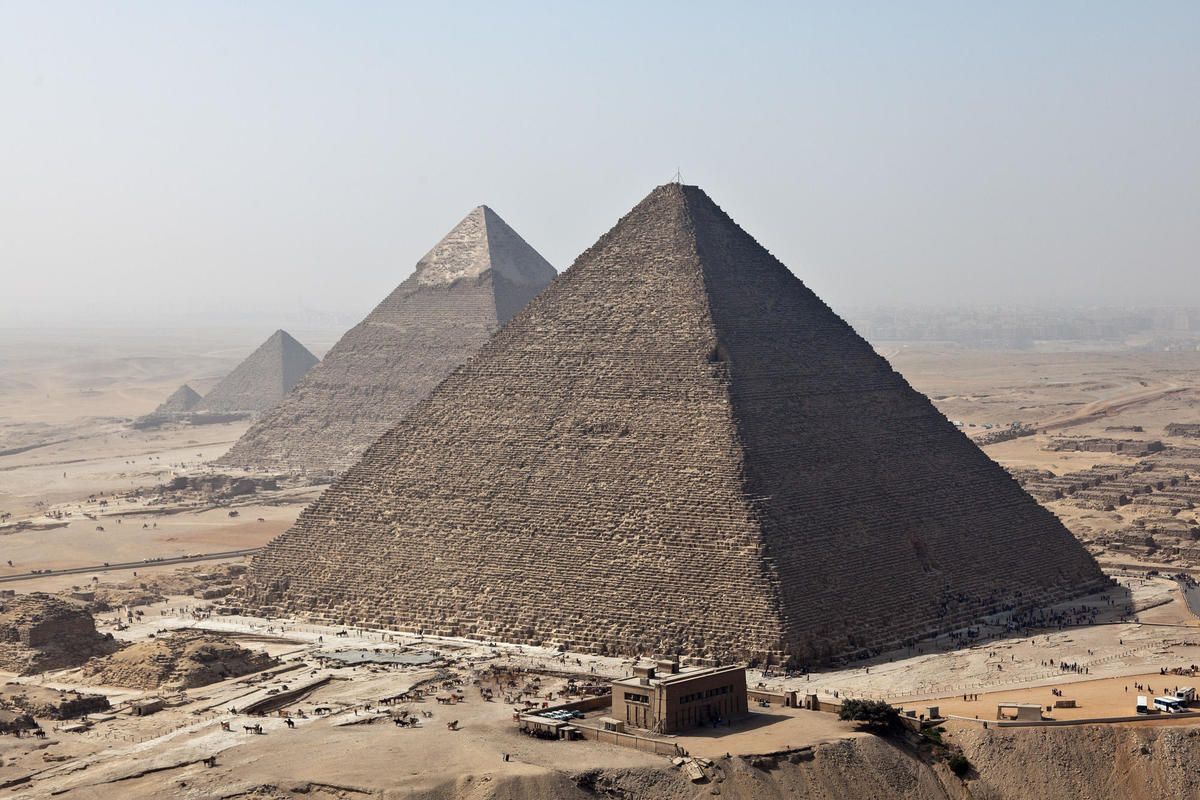 The three great pyramids of Giza. Rapid progress is being made to unravel their mysteries. (Photo: Yukinori Kawae)
The three great pyramids of Giza. Rapid progress is being made to unravel their mysteries. (Photo: Yukinori Kawae)
Kawae is at the forefront of pyramid research, but he did not follow the conventional path to become a researcher. Having been unsuccessful with university entrance exams in Japan, he traveled to Egypt at the age of 19. A television program had triggered his interest in pyramids when he was in middle school, and seeing his fascination in pyramids, his martial arts instructor encouraged him to go to Egypt. After spending some time as a tour guide of ancient sites, he eventually entered the American University in Cairo at the age of 27. Though it was a late start for university, he was passionate about decoding the mysteries of the great pyramids. When he graduated in 2004, he joined Dr. Lehner's excavation team, having met him at a lecture. In the process, he had numerous achievements, including the discovery of many mud seal impressions engraved with information about the owners and contents of the materials being sealed.
Kawae's connection with Meidai began in 2008 when he returned to Nagoya, hometown of his wife Hitomi, for her medical care. Professor Yoshiyuki Suto (ancient Greek history), who he had first met at an excavation site, happened to be at Meidai, so Kawae decided to seek a doctoral degree here. He was quite the exception as the humanities had few examples of a working adult becoming a student in a university program, and on top of that, he sought a PhD without first having the usual prerequisite master's degree. Nevertheless, he was accepted into the program on the strength of many papers he had written on excavations in Egypt.
He was already 39 when he obtained his PhD in 2012. The Japan Society for the Promotion of Science had a research fellowship funding program and there was an age limit at that time. Kawae was already above it and therefore unable to apply. The only program with no age restriction was a Restart Postdoctoral Fellowship (RPD), which was intended to fund female researchers who had suspended their research for child care. Kawae applied for the RPD, as he had become a single parent, raising his three young children after his wife passed away while he was studying for a PhD, and became the first male to utilize the program. Thereafter, the word "female" was removed from the documentation, and males too are now able to apply.
After three years of funding, he became a researcher with no salary. He continued to pursue his research while covering his cost of living through activities such as appearing on television programs and lecturing about pyramids. The television work involved activities such as twice climbing a pyramid, measuring the size of individual stones, and researching the interiors of pyramids, all of which contributed significantly to his research. It is usually not easy to get official permission for pyramid research, but the merits of being involved in television programs that would inform a broad audience apparently smoothed the process of obtaining permits.
In his teens, he dreamed of unveiling the mysteries of the great pyramids, and now he had persevered on his path to do exactly that. In research as well, he did not confine himself to the constraints of existing disciplines. "I just use what I need," he says. In 2016 he was selected by the National Geographic Society as an Emerging Explorer, a bold researcher with a progressive vision, with his approach to archaeology described as incorporating innovative technologies to help decode the mysteries of the pyramids.
Then, in the autumn of 2018, he was given a full-time post as Associate Professor at the Institute for Advanced Research, an academy at Nagoya University that conducts interdisciplinary research.
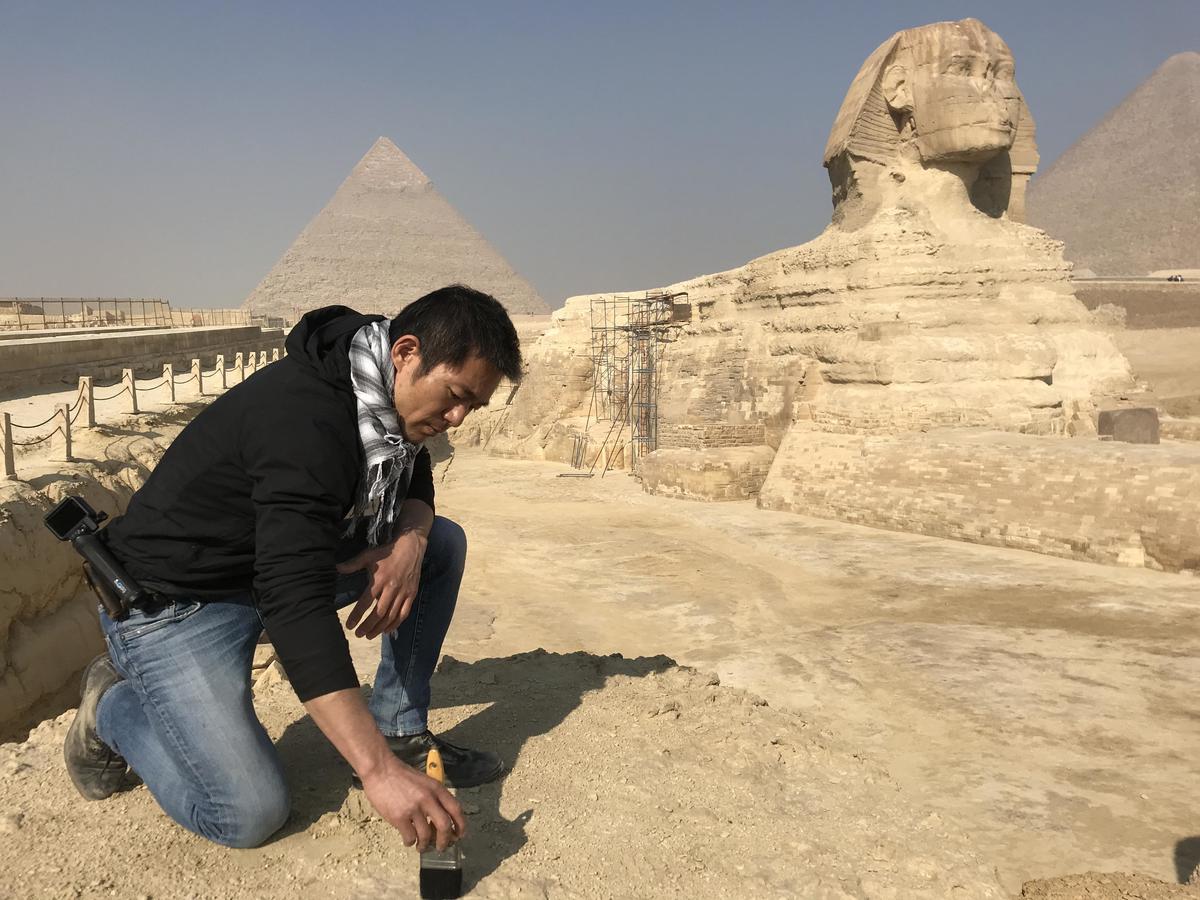 Professor Kawae stayed in Egypt for 16 years, which he says is the longest he has lived in one place so far. (Photo: Yukinori Kawae)
Professor Kawae stayed in Egypt for 16 years, which he says is the longest he has lived in one place so far. (Photo: Yukinori Kawae)
What he really focuses on, like his academic mentors, is precise data from onsite measurement. He has been working on 3D measurements since 2006. This involves creating 3D images based on laser measurements and images. In 2013, he launched an industry-academia partnership "Giza 3D Survey" project team with the participation of researchers from engineering and other disciplines. He already had images shot when he climbed the pyramids but they did not cover everything. The use of drones would enable more extensive imaging, but the term for drone in Arabic is "spy plane," so he expected that official permission would not come easily. However, due in part to having been selected as an Emerging Explorer, he had the good fortune of obtaining a special permit to use a drone in research for a television program. Initial work with drones began in 2016, and the main research got under way in February 2017. He says he shook with amazement when he saw the scene from the crest of the pyramid for his first time ever.
To gather the funds needed to analyze the mountains of data obtained, he started a crowd-funding campaign in September 2018 and raised over 15 million yen. In August 2019, he and his colleagues announced the completion of the world's first 3D images of the three great pyramids.
To create the 3D data the team used cutting-edge Structure from Motion (SfM) software, which first appeared in about 2012. It creates 3D images from images taken from various angles, and accurately depicts every stone with a resolution of one centimeter. SfM is also being used for Ryugu research, but because the Hayabusa2 is taking images from space above asteroid, its 3D images of Ryugu have a resolution of about 10 centimeters.
Professor Suto, the supervisor of Kawae's doctorate program and now Director of the Institute for Advanced Research, says he is astounded that Kawae's activities are far beyond Japanese scale. He is promoting projects, bringing in researchers from various disciplines, and attracting research funding from various sources. His likable personality is also a major factor. Suto is amazed with the huge potential, saying "He seems to be changing the image of the humanities, and he exactly embodies a model for interdisciplinary research."
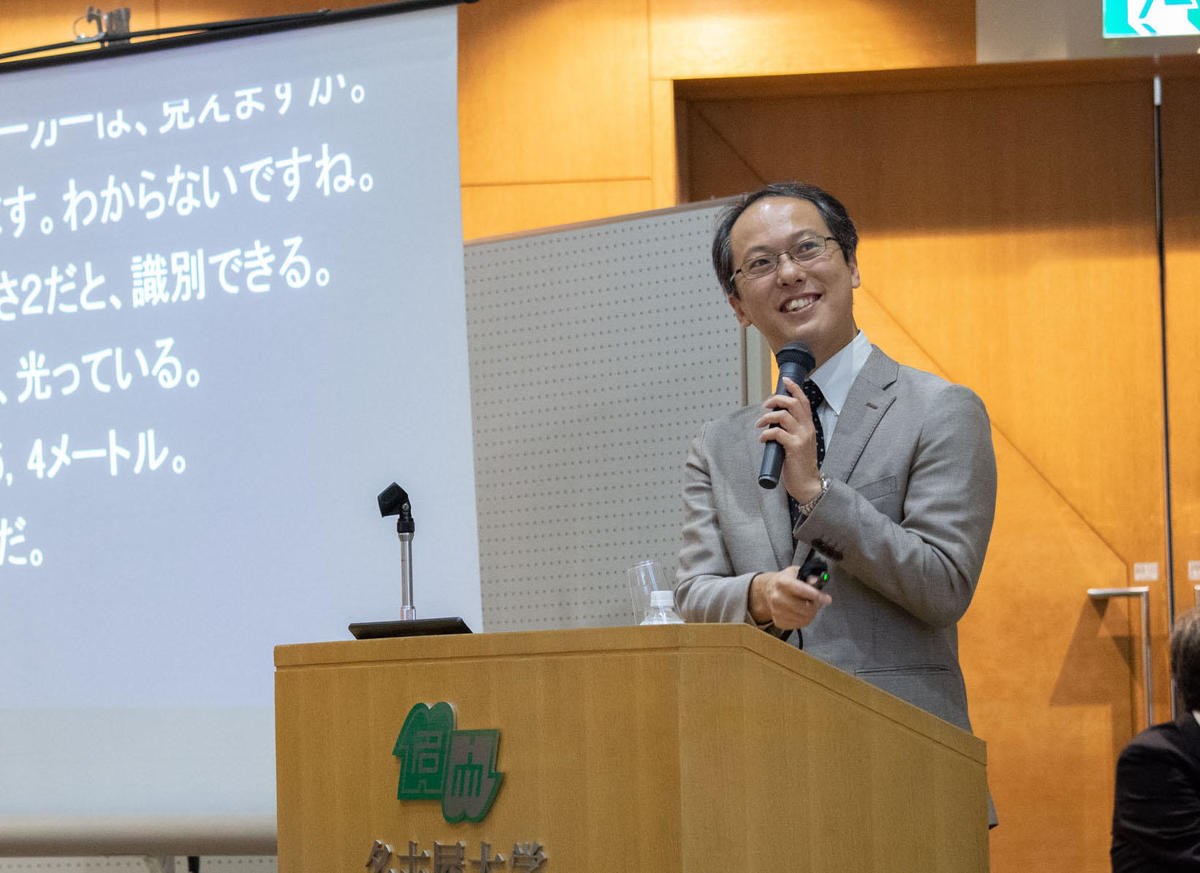 JAXA’s Associate Professor Yuichi Tsuda gives a special lecture on “The Challenge of Asteroid Explorer Hayabusa2” for Nagoya University Home Coming Day (October 19, 2019)
JAXA’s Associate Professor Yuichi Tsuda gives a special lecture on “The Challenge of Asteroid Explorer Hayabusa2” for Nagoya University Home Coming Day (October 19, 2019)
The pyramids were a human endeavor. They are now in the process of being explained by leading-edge science, and there is actually a connection with Hayabusa2. That was what I realized when I heard a lecture by Associate Professor Yuichi Tsuda, project manager for Hayabusa2 at JAXA, as part of a special event entitled "To Space and to Earth: Science is opening the path for the future of society," organized by the Institute for Space-Earth Environmental Research (ISEE) for Nagoya University Home Coming Day. When asked why we should go to space, Tsuda replied, "Human civilization has progressed by using cutting-edge science and technology to expand its endeavors. We use cutting-edge technology to understand the mysteries of space, so in other words, space is where we utilize the cutting-edge technologies." He said, "When we are sure that the mysteries continue to grow, we definitely go there," and added, "Actually, one wonders if it is right not to reach out to learn more when we can see a mystery before us." He also spoke of the passion for "Exploration to open the doors for humanity." This is exactly the kind of passion that has helped human civilization to blossom so far.
The pyramids are also objects that were built with the leading-edge technology of the day. Why did people build them? I look forward to the day when the answers are revealed.
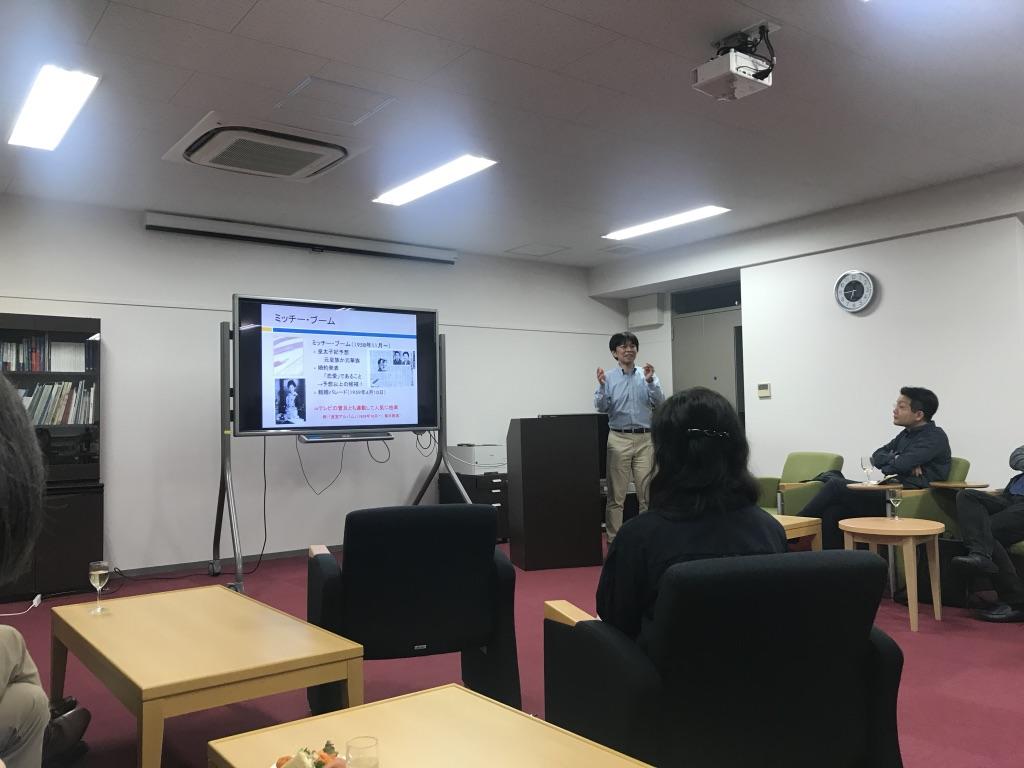 Just before the Japanese imperial transition on the last day of April in 2019, Associate Professor Hideya Kawanishi spoke at the Meidai Salon. He is known for his research into the symbolic emperor system. (April 22, 2019)
Just before the Japanese imperial transition on the last day of April in 2019, Associate Professor Hideya Kawanishi spoke at the Meidai Salon. He is known for his research into the symbolic emperor system. (April 22, 2019)
The Meidai Salon where Kawae presented his lecture was a regular gathering that originally started once a month in September 2002, as a forum for interdisciplinary intellectual exchange at Nagoya University. Its hundredth gathering was held in December 2010. The venue was a restaurant on campus, and after the speaker's presentation, participants would converse over wine and other drinks. Starting in 2004 the events were also open to the public, and the presentations were covered by Nagoya's Chunichi Shinbun newspaper each time. At the inaugural event, then Arts and Humanities Professor Shoichi Sato, who had just been awarded the prestigious Japan Academy Prize, made a presentation titled a "Western Medieval Historian Atelier." A booklet commemorating the series of 100 salon events shows that the speakers consisted of very diverse and noteworthy individuals. Professor Satoru Ikeuchi of Meidai's Graduate School of Science spoke about "University Theory" in 2003 before Meidai obtained new legal status as a university. Professor Takao Kondo of the Graduate School of Science (and who this year was selected as a Person of Cultural Merit) spoke in 2010 on circadian clocks. For the 99th Salon event, Professor Watanabe spoke about the first Hayabusa probe and asteroid formation, as the probe had just returned to Earth with samples from the Itokawa asteroid.
According to Professor Yasuo Fukui at the Graduate School of Science, a decision was made to stop with the hundredth gathering, since participation from the university was not growing beyond about 30 persons and it took considerable effort to organize the events. However, there were persistent calls for this kind of intellectual salon, so preparations began in the summer of 2018, and it was decided to resume on a trial basis once every two months for university participants only, starting in the autumn of 2018.
In April 2019, before Japan's transition to the Reiwa era, Associate Professor Hideya Kawanishi from the Graduate School of Humanities, Department of Humanities, spoke about the "History of the Emperor System in Heisei and Context for Abdication." In June, Professor Sayaka Oki from the Graduate School of Economics, Department of Socio-Economic Systems, spoke about "Moral Science and Nineteenth Century Japan." In August, Watanabe spoke about "The inside story of the Hayabusa2 challenge." I can see that the timely and intriguing lectures continue to come.
There is something wonderful about a multidisciplinary university. Unique research is going on everywhere. I am certain that interdisciplinary exchanges and interaction will continue to be important for academic disciplines going forward, and I hope initiatives like this will flourish.

 Subscribe to RSS
Subscribe to RSS